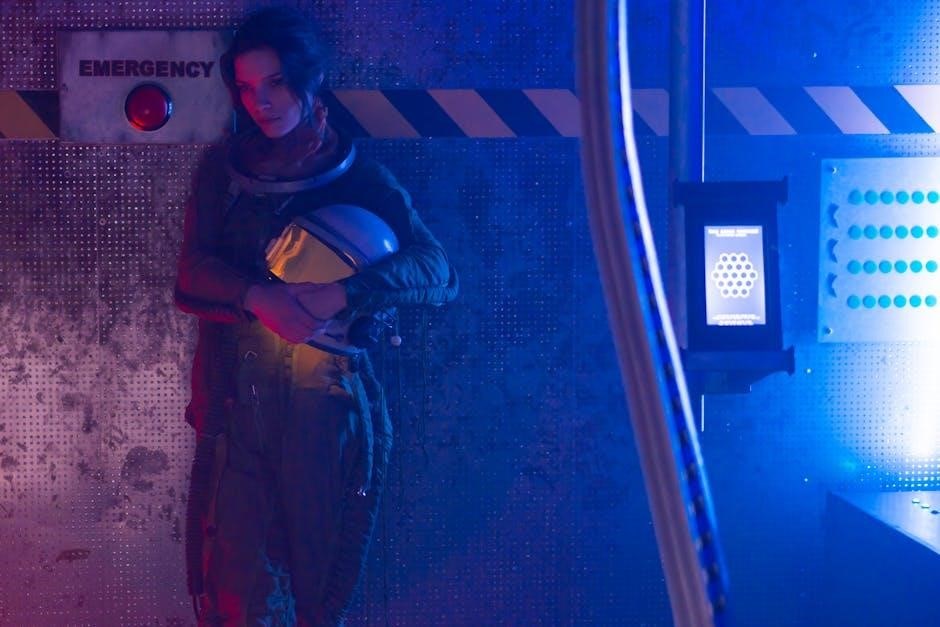An emergency lighting system is a critical safety component in buildings, providing illumination during power outages or failures. These systems ensure safe evacuation, prevent accidents, and maintain order in emergencies. They typically consist of LED lights, batteries, and charging mechanisms. Regular maintenance and troubleshooting are essential to guarantee functionality. This guide offers insights into common issues like battery failures, charging malfunctions, and LED problems, helping you ensure reliability and compliance with safety standards.

Common Issues and Solutions

Emergency lighting systems often face issues like faulty batteries, charging malfunctions, or LED failures. Common problems include lights not turning on, dim illumination, or constant operation. Quick fixes involve checking battery connections, testing switches, and ensuring proper installation. Regular maintenance, such as battery inspections and LED checks, can prevent failures. Consulting the manual or a troubleshooting guide is essential for resolving specific issues effectively and ensuring system reliability during emergencies.
Battery Inspection and Replacement
Battery inspection and replacement are crucial for maintaining the reliability of emergency lighting systems. Over time, batteries can degrade, leading to system failures. Start by checking the battery terminals for corrosion or loose connections, which can prevent proper charging. Ensure the battery is fully charged and test it under load to confirm its capacity. If the battery is old or damaged, replace it with a compatible type, following the manufacturer’s guidelines. After replacement, conduct a full system test to ensure everything functions correctly. Regular inspections can prevent unexpected failures, ensuring the emergency lights are ready when needed.
When replacing the battery, always disconnect the power source to avoid electrical hazards. Refer to the user manual for specific instructions, as different systems may have unique requirements. Keep spare batteries on hand to minimize downtime during replacements. Additionally, consider upgrading to maintenance-free batteries to reduce future inspection needs. Proper handling and disposal of old batteries are essential to prevent environmental harm. By prioritizing battery health, you can ensure your emergency lighting system remains dependable in critical situations.
Scheduling regular battery inspections, ideally every six months, can help identify issues early. Use a multimeter to check voltage levels and ensure they meet the specified requirements. If the battery voltage is below the recommended threshold, it may be nearing the end of its lifespan. Addressing these issues promptly not only extends the system’s lifespan but also guarantees compliance with safety regulations. A well-maintained battery ensures the emergency lights will activate reliably during power outages, providing the necessary illumination for safe evacuations and operations.

Charging System Malfunctions
Charging system malfunctions are a common issue in emergency lighting systems, often leading to battery undercharging or overcharging. These problems can arise from faulty chargers, incorrect AC power supply, or damaged charging circuits. If the charging system fails, the battery may not hold enough power to illuminate the lights during an outage, compromising safety. To diagnose such issues, check the system’s test switch and LED indicators, which often provide visual cues about the charging status.

If the test light is not illuminated, it may indicate a loss of AC power or a broken connection in the charging circuit. Ensure the system is properly plugged into a functional outlet and that all internal connections are secure. Consult the user manual for specific guidance, as different models may have varying indicators and troubleshooting steps. In some cases, the charging system may require professional servicing or replacement parts to restore functionality.
A common fix involves testing the AC power input and verifying that the charging module is operational. If the system uses a microprocessor, it may display error codes that correspond to specific malfunctions. Referencing the manual or contacting the manufacturer can help interpret these codes and guide the repair process. After addressing the issue, perform a full system test to ensure the lights activate correctly and the battery charges as intended.
To prevent future malfunctions, inspect the charging system annually and clean any dust or debris that may interfere with its operation. Additionally, ensure that the system is compatible with the building’s power supply and that no electrical surges or outages have damaged the components. Regular maintenance can extend the lifespan of the charging system and ensure the emergency lights remain reliable in critical situations.

LED Light Issues

LED lights are a critical component of modern emergency lighting systems, known for their energy efficiency and long lifespan. However, like any component, they can experience issues that affect performance. Common problems include dimming, flickering, or the LED not illuminating at all. These issues can stem from faulty connections, driver failures, or overheating.
If an LED light is dim or flickering, it may indicate a problem with the power supply or the LED driver. Check the wiring to ensure all connections are secure and free from damage. If the issue persists, the LED driver might need replacement. Overheating can also cause LEDs to dim or fail prematurely, so ensure proper ventilation around the fixture and avoid installing them in overly hot environments.
In some cases, LEDs may change color or emit uneven light, which could signal a failing driver or a malfunction in the internal circuitry. Consult the user manual for specific troubleshooting steps, as different models may have unique diagnostic features. For example, some systems use color-coded LED indicators to signal specific issues, such as a red light for a power failure or a yellow light for a battery issue.
If the LED fails to turn on during testing or an actual power outage, it may be disconnected from the power source or the control circuit. Verify that the test switch is functioning correctly and that the system is receiving AC power. If the LED still does not activate, it may be time to replace the entire LED module or the fixture itself.
Regular maintenance is key to preventing LED light issues. Dust and dirt can accumulate on the lens, reducing light output, so clean the fixture periodically. Additionally, ensure that the system is tested monthly to identify and address any potential problems early. By addressing LED light issues promptly, you can maintain the reliability and effectiveness of your emergency lighting system.




